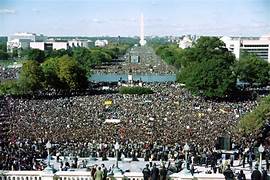On October 16, 1995, the United States witnessed a historic gathering in Washington D.C. known as the Million Man March. Organized by African American activist Louis Farrakhan, the march drew hundreds of thousands of participants, primarily African American men, to advocate for unity, justice, and social change. The Million Man March was a call for African American men to come together and address the social, economic, and political challenges facing their communities. It aimed to promote self-improvement, personal responsibility, and a commitment to family and community values. The march sought to foster a sense of unity, empowerment, and collective action among African American men. The march was significant in its size and impact. Estimates vary, but it is believed that between 400,000 to 1.1 million men participated in the event, making it one of the largest gatherings in Washington D.C.'s history. The immense turnout demonstrated the strong desire for change within African American communities and the power of collective action. The Million Man March was not without controversy. The event drew criticism from some who disagreed with Farrakhan's leadership and controversial statements in the past. However, many participants saw the march as an opportunity to address the pressing issues affecting African American communities and to rally around a common cause. The march emphasized the importance of self-improvement and personal responsibility. It encouraged participants to take ownership of their lives, families, and communities. The call for responsibility resonated with many African American men who felt disenfranchised and marginalized within American society. The Million Man March also sought to address issues of racial injustice and inequality. It aimed to draw attention to the systemic barriers faced by African Americans and to advocate for social and economic justice. The march served as a platform for speakers to address these issues and call for change on a national level. The impact of the Million Man March extended beyond the event itself. It sparked conversations and debates about race, social justice, and the role of African American men in society. The march inspired many participants to become more politically engaged and active in their communities, leading to increased grassroots organizing and advocacy efforts. The Million Man March also had a lasting impact on subsequent movements and gatherings. It served as a model for other large-scale demonstrations, such as the Million Woman March in 1997 and the Millions More Movement in 2005, which aimed to address similar issues affecting African American communities. Critics of the Million Man March argued that it did not result in tangible policy changes or systemic reforms. However, supporters emphasized the importance of the march as a symbolic and transformative event. It provided a platform for African American men to come together, share their experiences, and demand change. The march served as a catalyst for dialogue and action, inspiring individuals and communities to work towards social, economic, and political progress. The Million Man March on October 16, 1995, remains a significant moment in American history. It brought attention to the struggles faced by African American communities and the importance of unity, responsibility, and activism. The event served as a powerful reminder of the collective power of individuals to effect change and create a more just and equitable society.
16 Oct, 1995 U.S.A. Million Man March
